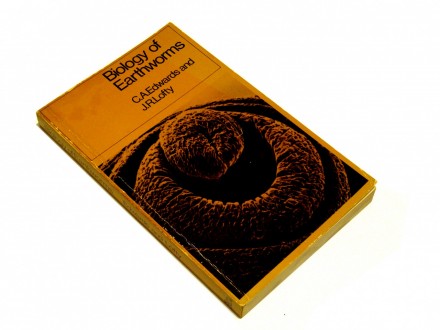Biology of Earthworms
| Cena: |
| Želi ovaj predmet: | 8 |
| Stanje: | Polovan bez oštećenja |
| Garancija: | Ne |
| Isporuka: | Pošta Post Express Lično preuzimanje |
| Plaćanje: | Tekući račun (pre slanja)
Lično |
| Grad: |
Beograd-Zvezdara, Beograd-Zvezdara |
ISBN: 0916302202
Godina izdanja: 1976
Oblast: Biologija
Jezik: Engleski
Autor: Strani
C. A. Edwards, J. R. Lofty - Biology of Earthworms
Bookworm, 1976
283 str.
meki povez
stanje: vrlo dobro
Opisthopora
Oligochaeta
Earthworms
Earthworms
Examines the earthworm through morphology, taxonomy, biology, physiology and looks at its environmental role.
1. Morphology.- 1.1 Segmentation: external.- 1.2 Chaetotaxy.- 1.3 Genital and other apertures.- 1.4 The clitellum and associated structures.- 1.5 Pigmentation.- 1.6 The body wall.- 1.7 The coelom.- 1.8 The alimentary canal.- 1.9 The vascular system.- 1.10 The respiratory system.- 1.11 The excretory system.- 1.12 The nervous system.- 1.13 The reproductive system.- 2. Taxonomy.- 2.1 Systematic affinities and descent.- 2.2 Families, genera and species.- 2.2.1 Moniligastridae.- 2.2.2 Megascolecidae.- 2.2.3 Ocnerodrilidae.- 2.2.4 Acanthodrilidae.- 2.2.5 Octochaetidae.- 2.2.6 Eudrilidae.- 2.2.7 Glossoscolecidae.- 2.2.8 Sparganophilidae.- 2.2.9 Microchaetidae.- 2.2.10 Hormogastridae.- 2.2.11 Criodrilidae.- 2.2.12 Lumbricidae.- 2.3 Geographical distribution.- 3. Biology.- 3.1 Life cycles.- 3.2 Reproduction.- 3.2.1 Spermatogenesis.- 3.2.2 Oogenesis.- 3.2.3 Copulation and fertilization.- 3.3 Quiescence, diapause and aestivation.- 3.4 Growth.- 3.5 Behaviour.- 4. Physiology.- 4.1 Respiration.- 4.2 Digestion.- 4.3 Excretion.- 4.4 Circulation.- 4.5 Nervous system.- 4.5.1 General.- 4.5.2 Light reactions.- 4.5.3 Chemoreception.- 4.5.4 Thigmotactic reactions.- 4.5.5 Responses to electrical stimuli.- 4.6 Water relationships.- 4.7 Locomotion and peristalsis.- 4.8 Regeneration.- 4.9 Transplantation.- 5. Ecology.- 5.1 Estimation of populations.- 5.1.1 Handsorting.- 5.1.2 Soil washing.- 5.1.3 Electrical methods.- 5.1.4 Chemical methods.- 5.1.5 Heat extraction.- 5.1.6 Vibration methods.- 5.1.7 Comparisons of methods.- 5.1.8 Number and size of samples.- 5.2 Size of populations.- 5.3 Population structure.- 5.4 Population distributions.- 5.4.1 Horizontal distributions.- 5.4.2 Vertical distributions.- 5.5 Seasonal populations and activity.- 5.6 Burrowing and casting.- 5.7 Species associations.- 5.8 Predators and parasites.- 5.9 Effect of environmental factors.- 5.9.1 pH.- 5.9.2 Moisture.- 5.9.3 Temperature.- 5.9.4 Aeration and carbon dioxide.- 5.9.5 Organic matter.- 5.9.6 Soil type.- 5.9.7 Food supply.- 6. The role of earthworms in organic matter cycles.- 6.1 Fragmentation and breakdown.- 6.2 Consumption, turnover and humification.- 6.3 Nitrogen mineralization.- 6.4 Effects on the C:N ratio.- 6.5 Effect on available mineral nutrients.- 7. Earthworms and micro-organisms.- 7.1 Effect of earthworms on number of microorganisms.- 7.2 Effects of earthworms on dispersal of microorganisms.- 7.3 Stimulation of microbial decomposition.- 8. Earthworms and soil fertility.- 8.1 Effects of earthworms on soil structure.- 8.1.1 Breakdown of soil particles.- 8.1.2 Turnover of soil.- 8.1.3 Formation of aggregates.- 8.1.4 Aeration, porosity and drainage.- 8.2 Earthworms as indicators of soil type.- 8.3 Effect of earthworms on crop yield.- 8.4 Soil amelioration by earthworms.- 9. Effects of agriculture on earthworm popu lations.- 9.1 Effects of cultivations.- 9.2 Effects of cropping.- 9.3 The effects of fertilizers.- 9.4 Mortality from pesticides.- 9.5 Uptake of pesticides into earthworms.- 9.6 Radioisotopes and earthworms.- 9.7 Heavy metals and earthworms.- 10. Earthworms as pests and benefactors.- 10.1 As pests of crops.- 10.2 As pests of grassland and turf.- 10.3 Control of earthworms.- 10.4 Transmission of diseases.- 10.5 Adverse effects on soil.- 10.6 Earthworms as benefactors.- 11. Simple experiments and field studies with earthworms.- 11.1 Cultures.- 11.2 Preservation.- 11.3 Dissection.- 11.4 Field experiments with earthworms.- 11.4.1 Distributions.- 11.4.2 Effects of pH.- 11.4.3 Production of casts.- 11.4.4 Incorporation of plant organic matter.- 11.4.5 Palatability of leaves.- 11.4.6 Burrowing experiments.- 11.4.7 Life history studies.- 11.4.8 Vertical and horizontal distribution of earthworms.- 11.4.9 Effects of insecticides on earthworms.- 11.4.10 Physiological experiments.- 11.4.11 Behavioural experiments.- A simplified key to common genera of terrestrial earthworms.- References.- Indexes.- Systematic.- Author.- General
Non Fiction, Biology
Plaćanje pouzećem i postnetom za sada nisu opcija.
Lično preuzimanje je isključivo na Konjarniku uz prethodni dogovor.
Hvala na razumevanju.
Predmet: 28723357







